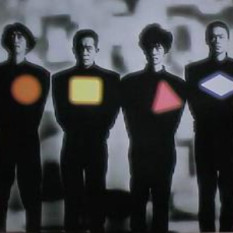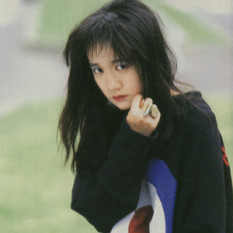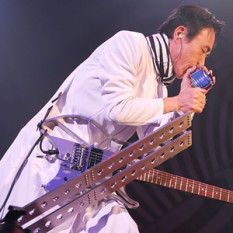Susumu Hirasawa (平沢進, born 2 April 1954 in Tokyo, Japan) is a Japanese electronic artist and composer.
In 1965, he started playing guitar, inspired by The Ventures, he joined a band with "older people" the following year. In 1972, he enrolled at Tokyo Designer Gakuin College. From 1972 to 1978, he performed in his first band Mandrake, a progressive rock/experimental group influenced by King Crimson, Yes, Black Sabbath and Pink Floyd. In 1979 he formed a synthpunk / electronic rock / techno-pop band called P-MODEL, along with two former members of Mandrake and a fan of the band/close friend. They released a string of albums through the 1980s, and in 1989, Hirasawa began releasing solo work, while also continuing to work with the reactivated P-MODEL beginning in 1992. The P-MODEL project continued until 2000; in 2004 Hirasawa started a new unit known as KAKU P-MODEL, which is effectively a solo continuation of P-MODEL.
Composition and performances
Hirasawa uses Amiga computers extensively in his work, using applications such as Scala, Bars and Pipes, and OctaMED in the production of his music. One of the factors that set him apart from other Japanese electronic artists is ever-changing production techniques. For 2001's SOLAR RAY album, his recording studio was outfitted to be powered completely by 2 solar energy-capting panels. Since them, Hirasawa's works have been recorded with solar energy, although he has since added 2 more panels to his studio.
His subject matter can be equally unusual. A constant source of inspiration for his music has come from Thailand. The concept behind his 1995 album Sim City was drawn from his experiences traveling there, and more specifically, from Thai transsexuals. Guest Thai vocalists participate throughout that and subsequent albums, including 1996's SIREN, which was also a concept album based on Thailand. As for his lyrical inspiration, Hirasawa references the philosophies of yin and yang, his travels and the principles of nature vs. machines. Hirasawa has also been inspired by the works of Carl Jung, Hayao Kawai, Kenji Miyazawa and Nikola Tesla.
Hirasawa occasionally stages interactive live performances. They merge computer graphics with his music to tell interactive stories, and involve heavy use of computers, particularly Amiga systems, motion capture cameras and video projectors. The flow of each live show is determined by audience participation; for example, Interactive Live Show 2000 Philosopher's Propeller was formatted as a maze, and the audience was allowed to choose which path to follow. Sometimes, audience participation plays a part in the performed music, as it did in Interactive Live Show 2000. He provided the phone numbers to four cellular phones during one song, and the audience was allowed to call the numbers to have him play the corresponding ringtone. This provided an improvised harmony between the background music and the ringing phones.
Hirasawa's live music is based on samples he activates with various hand-crafted sampler machines, pre-recorded tracks without vocals, and no regular backup performers. For the Hirasawa Energy Works - Solar Live LIVE SOLAR RAY concerts, he used solar power and a power-generating wheel, inspired by bicycles, to power his electronic equipment. DVDs are available of his innovative award-winning live performances via his website (and ordering through TESLAKITE).
During the PHONON2555 concert, he had two backup performers for the first time since 2000 (discounting those who participated as part of the plots of his Interactive Live Shows). .
All albums
You can find information through the best music search engine - Muzlan.top 😊All materials on request "平沢進" are available on page 平沢進
Yes of course. You can listen tracks on the page 平沢進
Yes of course. You can download tracks on the page 平沢進
This page is found by queries: 平沢進 song listen, 平沢進 remix, 平沢進 free download, 平沢進 song download, 平沢進 all mp3




